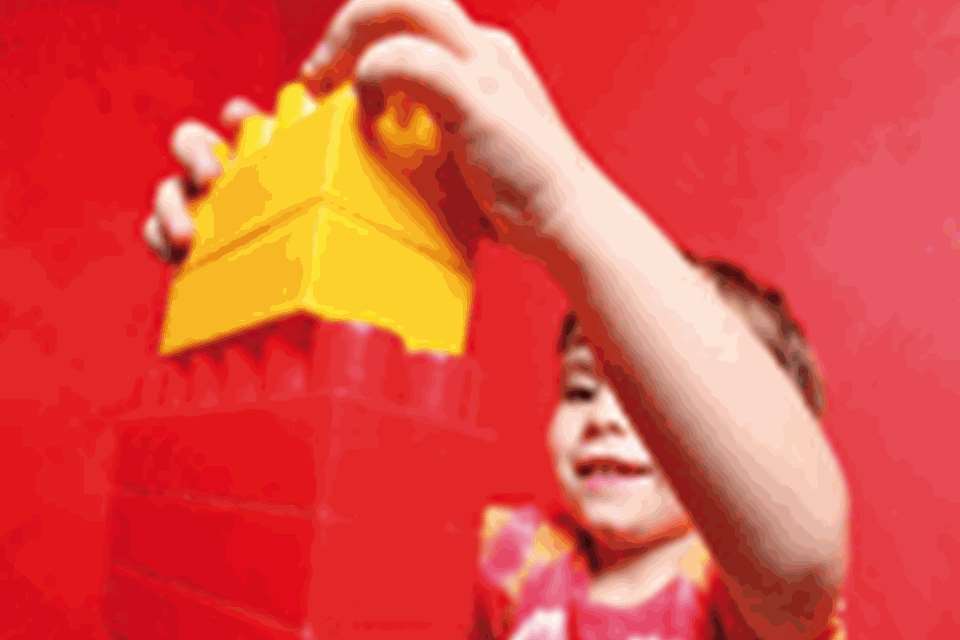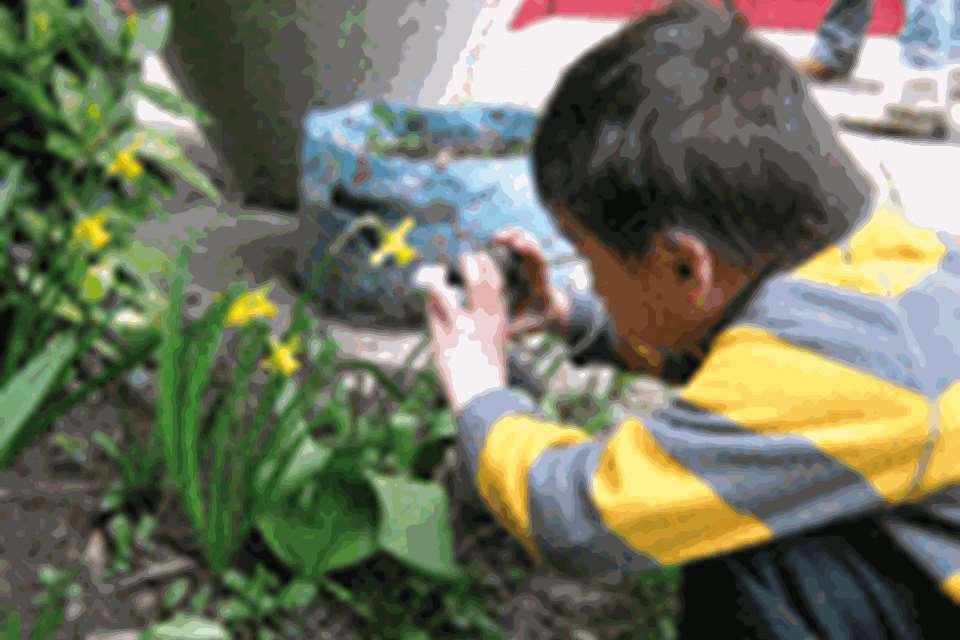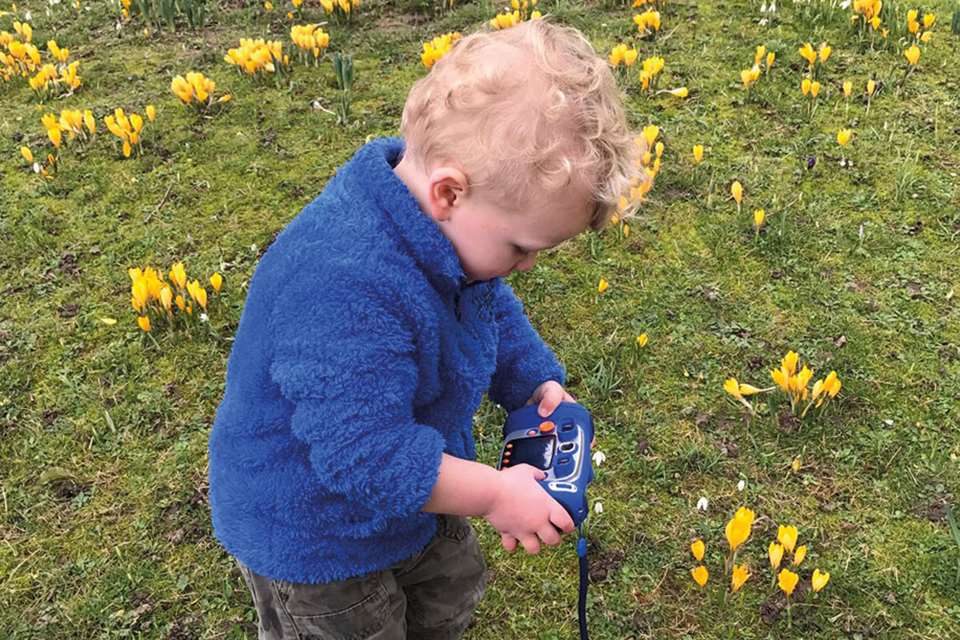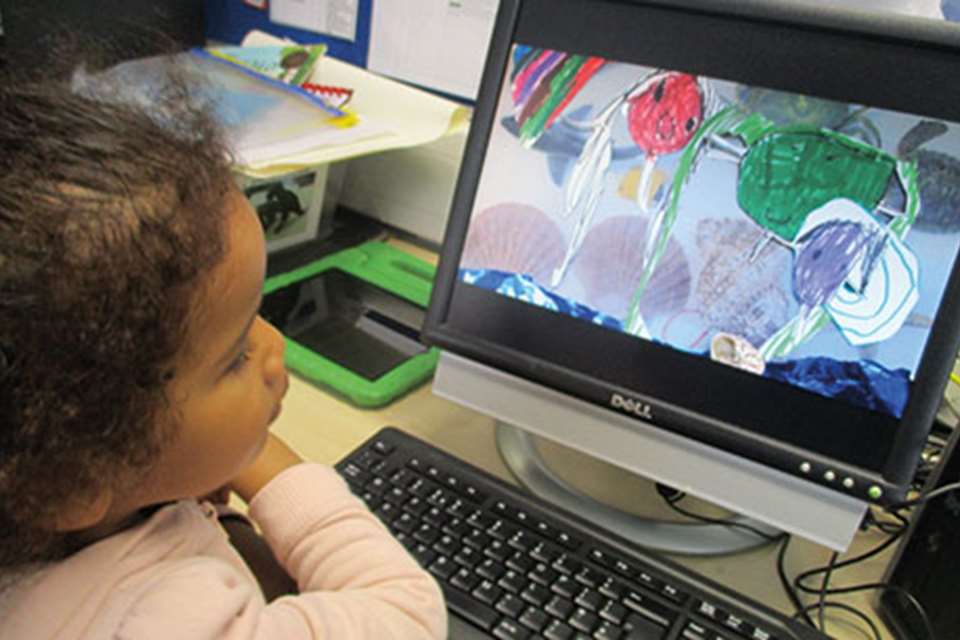EYFS best practice - All about… photography
Pete Moorhouse
Monday, July 9, 2018
Photography is more than a visual art form and can unlock conversations with children, explains Pete Moorhouse, who also offers some practical advice
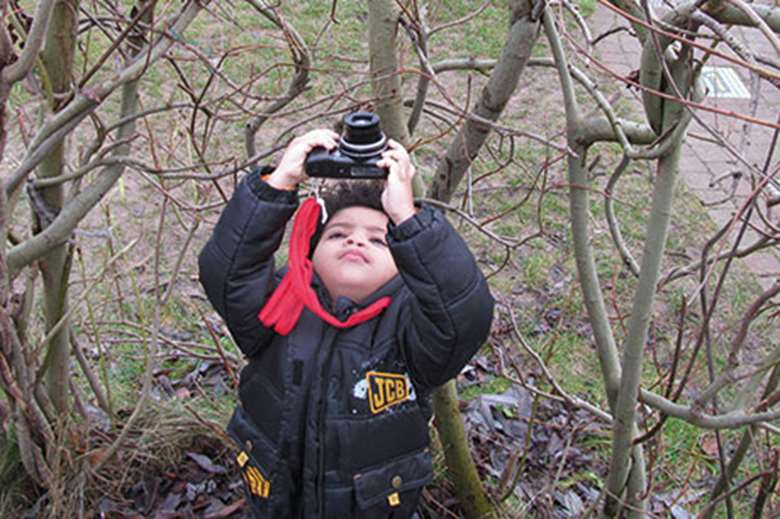
Download the PDF of this article
Several years ago, I invited children to photograph things that they felt were beautiful in their nursery – and the resulting images were extraordinary. Among them was three-year-old Mira’s image of an overflowing drainpipe, which captured the falling water in the sunlight. It brought home to me just how complex and visually aware young children are – and the rich potential of photography for learning and self-expression.
Photography, however, remains an underused children’s resource in early years practice. Practitioners regularly use cameras and tablets to document children’s learning, but this is rarely extended to children – often out of concern for the camera being damaged but perhaps also due to lack of awareness about the many possibilities of using photography with young children.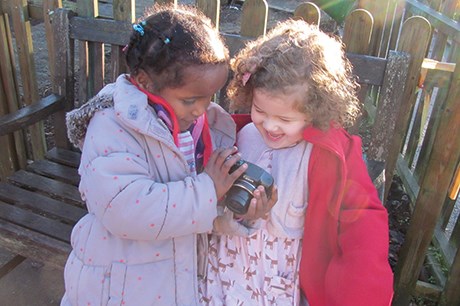
THE POWER OF PHOTOGRAPHY
During my years as an artist educator at St Werburgh’s Park Nursery School in Bristol, I have discovered how powerful a medium photography is for developing children’s understanding of themselves and the world around them. It puts children at the centre of their learning, engages their curiosity and provides a starting point for enquiries.
Photography is a language all of its own, is accessible to all children irrespective of gender, culture and background, and can be an engaging medium for children with a wide range of special educational needs and disabilities.
Photography provides a different way for children to express themselves and making their ideas visible. For some children, photography seems to be a key that unlocks their learning and becomes a strong language of expression (see case study). Children use their imagination, naturally seeking out unusual perspectives and are not confined by conventional ideas of what makes a ‘good’ photograph.
Photography builds on children’s intrinsic motivation and exploratory drive. By following their curiosity and taking their own pictures they are deciding what is important and constructing their own meaning of their experiences. The resulting images are often unexpected and striking. Children view the world in unique ways and the camera allows them to capture these perspectives.
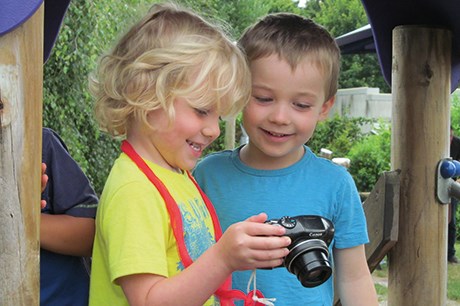
A child’s voice: a picture and a thousand words
Initially, I thought photography would provide children with another visual art form to work with. However, after introducing digital cameras to children several years ago, it quickly became apparent just how much more potential there was to photography, especially for opening up conversations.
Photography provides an exceptional tool for encouraging children’s voice. Children feel a sense of ownership over their images and readily communicate the ideas behind them. They are empowered as they know the information and the thinking behind the images that we don’t.
Children like having their images as the focal point and these become the starting point for conversation as adults and children view images together. Children make meaningful reflections about their images and these often become a way of starting new dialogues and enquiries. In the pre-schools of Reggio Emilia, they have been using cameras for many years and they talk of the ‘language and dialogue’ of photography, so highlighting its rich potential for developing communication.
Unique insight
Photography gives practitioners a unique insight into the way a child sees the world around them, making their interests visible and opening up opportunities for following and developing their lines of enquiry. For this to be effective, we have to ensure that we make time and space to listen carefully as the images are reviewed together.
Versatility
Photography is extremely versatile – it can be an interest in itself or used to support other enquiries, recording outings and so on. The images can be viewed instantly on the camera, downloaded and viewed on a laptop or PC, a TV or whiteboard, projected on a wall or printed. Images that are printed can then be used in many ways – for mark-making, drawing on, creating a collage, making a storybook and so on. Images can also be reworked digitally with a variety of apps. The possibilities are endless.
Documentation
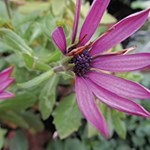 Photography is a powerful tool for children to become documenters of their own work – documenting both the process and product. Photographs taken by children have a deeper significance and it is easier for the children to re-connect with them. This can contribute to children reflecting and evaluating their learning, developing their metacognitive understanding, and thinking about ‘next steps’ in their explorations and learning.
Photography is a powerful tool for children to become documenters of their own work – documenting both the process and product. Photographs taken by children have a deeper significance and it is easier for the children to re-connect with them. This can contribute to children reflecting and evaluating their learning, developing their metacognitive understanding, and thinking about ‘next steps’ in their explorations and learning.
The documented images provide a memory link to previous experiences – and these are even more relevant and memorable for being taken by the children themselves. This can be particularly useful when documenting work that happens over a longer time frame, such as exploring the seasons, the weather or growing seeds. Photography can also be a useful tool for children to record a temporary construction that has to be dismantled, often making them feel happier about having to clear it away.
Consultation
Photography can provide an interesting way of consulting with children, gathering their ideas and having them feed ideas into evaluation. This could be consulting with children about what changes they would like to see in their environment, such as in the playground. If we ask direct questions, the conversation may be limited, but by suggesting children take images of things they like and dislike, then reviewing the images together, this can really stimulate a dialogue and exchange of ideas.
Similarly, we can use photography to evaluate children’s time at nursery at the end of the year – by taking pictures of learning that had been significant, what they liked to play with and so on. This can provide extraordinary and sometimes unexpected insights. The Mosaic approach to consulting with children highlights the value of using photography as a medium for consultation.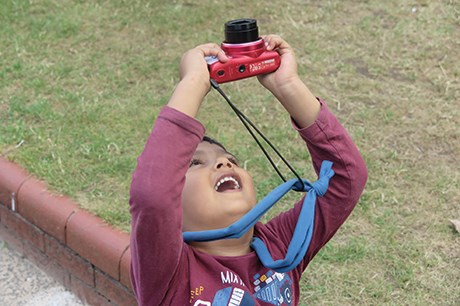
MAKING THE MOST OF PHOTOGRAPHY
Getting started
Engage children in discussions about images and photography to assess and develop their awareness of photographs and how they are produced. This could include looking at images in magazines or visiting a photographic exhibition.
At St Werburgh’s, we explore equipment with lenses to develop understanding of photography and encourage observation. This could include magnifying glasses, a USB digital microscope or projecting images captured with a web camera.
Providing guidance
If children are to enjoy all the benefits of photography, we need to give them clear instructions on how to use the camera, and this is best done on a one-to-one basis.
Start by explaining the need to:
- handle the camera with care and protect it from damage
- wear the neck strap at all times
- avoid running with the camera.
When it comes to using the camera, explain:
- how to switch it on and off
- which button takes the image
- how to focus (‘half press’ in the case of a camera, and wait for the circle or square to disappear on a tablet)
- the importance of holding the camera still and keeping their figures from obscuring the lens
- how to zoom in and out
- how to switch between review mode and shooting mode
- how to delete unwanted images.
It is also worth discussing the etiquette of taking photographs – for example, asking people’s permission to take photographs and respecting the wishes of people who do not want their picture taken.
After the initial instruction, give children time to take practice shots so that they can gain confidence in operating the camera and framing the image. Then they are ready to explore. It’s a good idea to take a portrait of the child first to help identify whose images are whose on the memory card.
Availability
Have the camera available as a resource that the children can access at any time. We do this by having a designated children’s camera – solely for their use. It hangs on the wall, where it is clearly visible but at a height that children cannot reach and so they must ask to use it. This emphasises the need to take care of this special equipment and for us to know who is using it and track whose images are whose.
Exploration
Most children will naturally follow their curiosity and experiment with photography, developing their technique and skill through trial and error. Where children do need encouragement to experiment, suggest taking shots:
- from different perspectives – such as from above and below, at unusual angles, in close up and further away, or from different sides
- of different subjects – such as portraits, objects, landscapes, details, buildings, and so on.
Importantly, give the children time to experiment and find their voice. We can support thoughtful picture-taking by encouraging children to take images that are important to them and by showing genuine interest in their resulting images.
Extended projects
When reviewing children’s images, themes often begin to emerge and these can then be developed and extended. We can also ‘invite’ children to use photography to explore a specific area.
These are so many possibilities for using photography with young children. It could involve the children taking the camera home over the weekend. Children enjoy sharing their images once they are back in nursery, talking about the people, places, events and objects that may be unfamiliar to the nursery staff but are important to the child. They also like to explain why they took the images – and their perceptions also fascinate parents. Such a project encourages a link between home and setting and provides an insight into children’s interests. Recording festivals and cultural events can also help children feel proud of their own culture.
In fact, there are endless lines of enquiry for children to pursue using photography, and here are just a few:
Making a photographic map of the setting
My journey to school
My home
All about me
My neighbourhood
What is beautiful?
Colour, texture and patterns
Reflections and shadows
Likes and dislikes
Portraits
What makes me happy?
Making a picture story book
The weather (including looking for shapes in clouds)
Growth
Seasons
Consulting with children – for example, on the layout of a room
Light painting – photographing light in a dark room on slow exposure.
Other lines of enquiry may also emerge – for example, they may decide to make cameras from junk-modelling supplies, disassemble a (broken!) camera, create paintings inspired by their images, or draw directly onto print-outs of their images.
Reviewing and reworking images
Photography is likewise versatile in the many ways in which images can be reviewed. We often see a huddle of children gathered around a camera looking at images that they have just taken. These can be viewed on a larger scale on a laptop, PC or white board. Images can be reworked digitally or printed. Printed images can, for example, be made into collages, drawn on or cut up.
Images can be shared with parents through displays, learning diaries, and slide shows. I particularly like adding children’s images to PowerPoint and adding some of their dialogue to the slides.
Video
While children do enjoy shooting video on a camera, tablet or mobile phone, our experience has been that it is harder for them to work with. It necessitates longer periods of time to review work and is harder to reflect on due to the quantity of information. It also ends up using significant amounts of memory on devices. I would suggest being led by the children – if they are showing interest, explore video as well.
Downloading and storage
Get into the habit of downloading the images off the camera after each session, and filing them in separate folders of each child’s work. This avoids an overwhelming build-up of images, which are then difficult to organise, especially if several different adults oversee the camera.
Exhibition
Children take pride in their images and in presenting them. This could be on a monitor or a wall display, or it could be taken one step further with the children exhibiting their favourite works in a public space such as a café, library or health centre.
This type of event is very popular with both children and their families. Some images could be framed or printed on large canvases. Children could choose the image they would like to display and their thoughts added as to why. People are often taken aback by just how interesting and striking their images are.
Safeguarding and permissions
When using a camera, children are often working independently, so we do not necessarily know what is in the images. On rare occasions, children may inadvertently take inappropriate images of themselves or others. So, it is important to review children’s images on the camera and delete any unwanted ones before downloading them to a computer. (Once uploaded, they are often automatically backed up on another server, making it harder to erase them completely.)
In terms of permissions, the same criteria should apply to photographs taken by children as to those taken by practitioners. So, parental permission is a must if the images are to be used in contexts such as on the school website or in publications. Practitioners should explain fully the proposed use of the images and obtain written permissions from parents.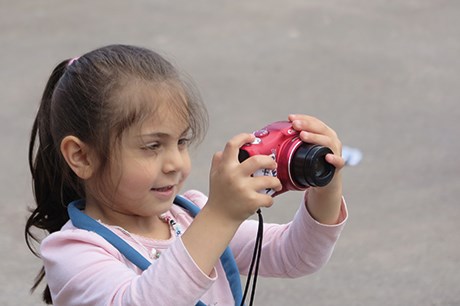
A GUIDE TO EQUIPMENT
Over the years at St Werburgh’s Park Nursery School, we have experimented with a variety of different cameras, tablets and other devices.
Second hand
I would strongly advise getting second-hand equipment, especially as there is so much available cheaply these days, as we constantly replace old equipment to keep up to date. Cameras will eventually break in the hands of young children, and using cheaper second-hand equipment can allow us to feel less apprehensive about damage, so allowing the children more freedom with the camera without us nervously hovering over them. We need to be comfortable with children handling cameras for photography in the early years to be successful.
Neck strap
It is important that children wear a neck strap to prevent the cameras being dropped, and I would recommend using ones that are relatively wide and made of fabric as they will be softer than other types.
Cameras
There are so many options available and there are pros and cons with each. I would advise prioritising something that takes good-quality images, and is easy to navigate and hold.
The types of camera that we have had most success with are small, high-quality digital cameras, as they take high-quality images, and have good processors and a fast response.
I am far from impressed with the selection of cameras made specifically for children. They are well protected with rubber mouldings but tend to be cheaply made with poor-quality processors and produce poor-quality images. They also tend to include additional effects, which become an unnecessary distraction.
I would recommend:
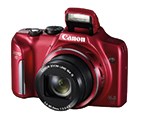 Canon PowerShot range SX110 to 170
Canon PowerShot range SX110 to 170
I particularly like this range as the cameras are robustly made, produce high-quality images, are easy to grip, have a relatively large screen on the back for reviewing images and take AA batteries. Only second-hand cameras are now available, but they can be bought for about £30 on eBay.
Nikon Coolpix W100
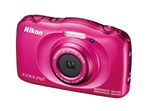 Shock-proof and waterproof; available in bright colours; from£129 new.
Shock-proof and waterproof; available in bright colours; from£129 new.
Fuji FinePix XP120 Action
Shock-proof and waterproof; fixed lens; available in bright colours; from £127 new
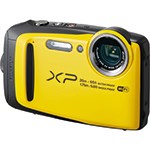 Tablets and mobile phones
Tablets and mobile phones
Many children are only too familiar with iPads and mobile phones. Large iPads are quite bulky for very young children to hold comfortably and tend to create a wall between the children and their subject.
There are protective mouldings available that incorporate handles which make them easier for young hands. Mini iPads and mobile phones (SIM cards removed) can work, but often children can get lost navigating the menu by accidentally touching an 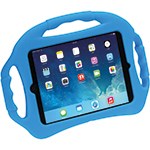 incorrect command. On balance, I would recommend using the digital cameras.
incorrect command. On balance, I would recommend using the digital cameras.
Useful apps for android or iOS
Apps that enhance children’s experience of photography include:
FirstCamera
‘The Camera for Kids’ – very simple to operate
PicCollage collates images into a collage
360 Panoramas provides wonderful 360-degree images
Lapse It and Hyperlapse enable you to take long-exposure photographs
For more detailed information on photographic resources, visit: https://irresistible-learning.co.uk/resource/childrens-photography
CASE STUDY: ALFI
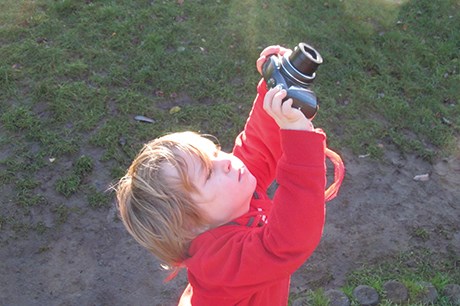 At St Werburgh’s Nursery School in Bristol we have embraced photography as a means of supporting children’s learning. Each of our nursery rooms has a camera for the children to use, images are reviewed with them on a laptop and shared with parents through a monitor in the foyer.
At St Werburgh’s Nursery School in Bristol we have embraced photography as a means of supporting children’s learning. Each of our nursery rooms has a camera for the children to use, images are reviewed with them on a laptop and shared with parents through a monitor in the foyer.
Alfi had noticed other children taking photographs and showed an interest in using the camera himself. I explained how to take care of it and demonstrated the basic functions. Alfi then took a few practice shots, and within a few minutes he was out exploring the playground. He observed various aspects of the environment and took many images – reviewing each on the camera before moving on to his next image.
Mostly, he worked independently, away from the gaze of an adult. He remained deeply engaged in his picture-taking for well over an hour. During this time, he explored many themes, starting with himself, then moving on to plants and trees, followed by the sky and plane trails, and then reflections in puddles and windows – each time taking a series of images within each theme.
In the Arctic
On one occasion, Alfi wanted to photograph an Arctic scene. He was experimental, first zooming in on the ‘icebergs’, capturing dramatic angles of the ice, then deciding ‘I’m going to take everything now’.
He tried to capture the entire scene but was not satisfied with the results. ‘I need to get more in,’ he concluded. So, he dragged over a bench, climbed up and took an aerial shot that captured the entire scene.
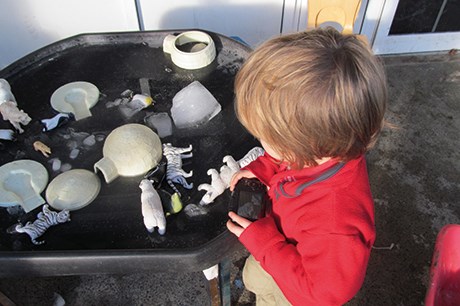
Two eyes and two legs
On another occasion, Alfi photographed two chalk circles on the playground Tarmac – ‘Here are two eyes,’ he said. He then noticed that the shadow of his two legs were also in the image – ‘Look! Two eyes and two legs! That’s funny.’ Now interested in pairs, he went off looking for other pairs of objects, such as two scooter wheels.
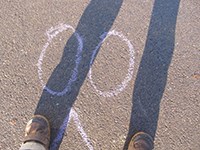 Reviewing the images, Alfi was clearly delighted with them, talking at length about each one – and more than we had heard from him before. He said he was keen to zoom in on small things. One of his images was of a dew drop, which triggered further explorations with the camera – namely, making small things big and observing the detail.
Reviewing the images, Alfi was clearly delighted with them, talking at length about each one – and more than we had heard from him before. He said he was keen to zoom in on small things. One of his images was of a dew drop, which triggered further explorations with the camera – namely, making small things big and observing the detail.
Unlocking learning
Alfi had engaged with various provocations, but nothing had come close to engaging him and focusing his attention in the way photography had. His experiences highlight the importance of providing a wide range of media for children to use in their explorations – in this case, photography really provided the key that unlocked Alfi’s learning. The camera allowed Alfi to ask questions and find his own answers all thorough the medium of photography.
PHOTOGRAPHY: CROSS-CURRICULAR LEARNING
Taking, reviewing and using images makes photography a truly cross-curricular activity. Here are examples of the learning that can flow from it:
Personal, Social and Emotional Development
Being trusted to use photographic equipment and having the skills to take and talk about their own photographs:
makes children feel valued and empowered
boosts their self-esteem and confidence
gives children a sense of agency – that ‘can-do’ spirit
develops their sense of self and belonging (when they take photos of themselves or their setting)
enables children to express their ideas and feelings
gives them a sense of pride.
Physical Development
Using photographic equipment helps children to develop:
fine motor skills and dexterity
hand-eye co-ordination
co-ordination and posture, as children keep still to take images.
Communication and Language
Photography opens up opportunities for:
conversations
learning new vocabulary and descriptive language
children who are reticent about using language or have language delay to express themselves.
Literacy
Photography enables children to:
explore non-fiction books about cameras or subjects relating to their photographs
mark-make on or about images
create and record stories
make scrapbooks of their photographs with captions.
Mathematics
Taking, downloading and reworking images enables children to explore:
size and measure
perspective and the language of position
shape
pattern
number.
Understanding the World
Through photography, children gain a deeper understanding of:
technology and how to use it
their lines of enquiry, such as gardening, insects and seasons.
Expressive Arts and Design
Taking, manipulating and reworking photographs provides children with another medium for self-expression and creativity.
Characteristics of Effective Learning
Photography can:
engage children’s curiosity
increase their motivation
encourage concentration and high-levels of engagement
develop their skills in planning, analysing and problem-solving.
Pete Moorhouse is artist educator at St Werburgh’s Park Nursery School, Bristol and an associate trainer for Early Education, studio@petemoorhouse.co.uk, https://irresistible-learning.co.uk 
MORE INFORMATION
Picture This: Photography Activities for Early Childhood Learning by Susan G Entz
National Geographic Kids Guide to Photography by Nancy Honovich
Slow Looking: The Art and Practice of Learning Through Observation by Shari Tishman
Pete Moorhouse’s CPD training on ‘The language and dialogue of children’s photography’, https://irresistible-learning.co.uk/training


